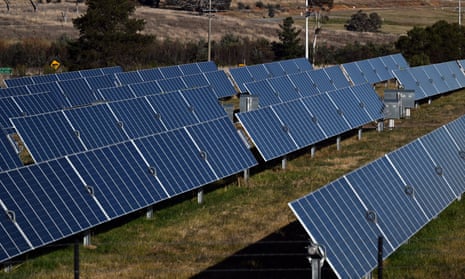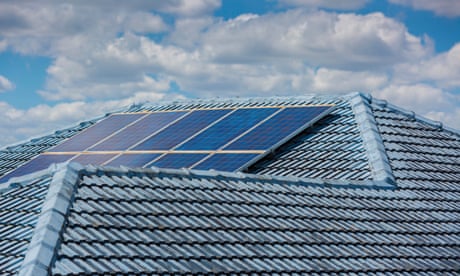
The opposition’s energy spokesperson, Ted O’Brien, suggested the Labor government could be “wilfully lying” about the “true cost” of the energy transition, while others have questioned the evidence that solar and wind are the cheapest forms of power.
In the Australian, two columns claimed to have uncovered a fatal flaw in how the cost of solar and wind gets compared with coal, gas and the currently-illegal nuclear.
There is a lot to unpick – but not because any true scandal has been uncovered.
Many of the claims centre on two reports that most Australians will not have heard of and even fewer will have spent any time reading.
Every year a small team at CSIRO produces a report called GenCost that discusses changes in the costs of different generating technologies and also ways to store energy, such as in batteries or dams.
Two columns in the Australian by Claire Lehmann have attacked one metric that’s calculated in the GenCost report known as the Levelised Cost of Energy (LCOE).
It’s a metric that’s used to illustrate how competitive different technologies are, and it takes into account costs such as fuel (for solar and wind that cost is zero, but for coal and gas it’s not) and how much electricity is generated.
The LCOE metric shows clearly that solar and onshore wind are easily the cheapest forms of electricity right now. But Lehmann, and critics she quotes, say it’s misleading because it does not account for the cost of adding transmission lines and storage to the grid that enable those renewables.
This is largely true, but is not a secret.
Right now, renewable energy is being installed on a system that includes expensive transmission towers and lines and that since its inception was designed, built and maintained to accommodate coal.
In calculating LCOE, the GenCost report treats planned spending on major transmission and storage projects, including Snowy 2.0, up to 2030 as already committed.
Lehmann and critics say treating these projects as “sunk costs” amounts to a “creative accounting method” and disguises the true cost of renewables.
But Lehmann doesn’t mention that the same GenCost report includes a long explanation of why this is done.
In short, a stakeholder in the year 2030 who wants to have an idea of the cost of building new renewable energy generation is not interested in investments that have already been made into the grid to integrate renewables.
And in 2030, the GenCost report shows the LCOE for solar and wind is far cheaper than any other technology, including the cost of any further investments that will be needed to be made to support high levels of renewable energy.
Lehmann described GenCost as “probably the most important document in Australia’s energy transition” – a statement that several energy system analysts told the Guardian isn’t true.
That document is the Australian Energy Market Operator’s Integrated System Plan – a mammoth 100 pages with a dozen supporting reports and appendices.
That plan’s raison d’être is to consult with industry and then lay out how to develop the electricity system for the coming decades to achieve reliability (the lights need to stay on), affordability (what’s the lowest cost mix of generation technologies, transmission and storage) and is in line with climate targets.
The challenge for Australia is not to just deploy the cheapest form of electricity. The question is “what’s the cheapest electricity system that’s reliable and will meet climate targets?”.
According to the ISP, the answer to that question is to use solar and wind energy, backed by storage. And, as energy experts pointed out to the Guardian, the ISP does not use the LCOE calculations from GenCost.
A $62bn black hole?
A story in the Australian last week claimed there was a “$62bn black hole” in Labor’s energy plan, and that this had been “exposed by industry experts and the Coalition”.
Actually, the story hung on the claim of one expert, David Carland. And the “black hole”, claimed by O’Brien, is fiction.
Carland’s analysis, seen by Temperature Check, lists a number of known projects that were already considered by Aemo when it produced its most recent ISP.
Carland argues several of these projects will cost more than was originally planned – and for Snowy 2.0 this is certainly true – but that’s very different from a project not being considered at all in Aemo’s plans.
Carland, who has previously pushed for Aemo to model a future electricity grid that continues to rely on coal, also identifies some other “costs” that should be considered before GenCost calculates LCOE for renewables.
Tennant Reed, the climate and energy director at Ai Group and an energy systems expert, reviewed Carland’s submission and questioned many of the assumptions made.
In a long email, Reed told Guardian Australia he thought Carland’s analysis included inflated numbers and double counting.
For example, Reed said the analysis includes a $1.6bn “cost” from state-based schemes that contract the supply of renewables.
He said even if that number was right, its inclusion was wrong because “these contracts don’t add to the underlying cost of renewables, they are part of how that underlying cost is paid for”.
Reed wrote that Carland’s analysis “fundamentally misses the point that ISP, not GenCost, is the relevant exercise for considering the optimal system development path to 2030 and beyond.”
The least-cost option?
Anyone suggesting the ISP ignores the cost of building an electricity system that’s centred on renewable energy compared with any other technology that’s available has likely not looked at the mountains of information available.
The ISP includes five major transmission projects that are part of its “optimal development path” and will cost $12.7bn to build ( they’re HumeLink, VNI West, Marinus Link, Sydney Ring and New England REZ Transmission Link).
But the report also says building these projects will realise benefits more than double their cost.
Without them, the report says, the NEM would have to rely on more expensive gas and offshore wind, raising costs and burning a hole in the carbon budget.
The GenCost report and the more relevant ISP are not the only pieces of analysis that suggest the cheapest way to build a reliable and low emission electricity system is to use renewables backed up by storage.
In 2019 the Grattan Institute published its “Go for Net Zero” report that found it was possible to turn off coal and get to very high levels of renewable energy without compromising on reliability.
Tony Wood, energy and climate change program director at the Grattan Institute, said they found that renewables backed by storage, and with gas-fired power as a back-up, delivered a reliable system that “costs probably about the same as it is today, but you now have a system with very low emissions. And you get the emissions reduction for free.”
Net Zero Australia was another major effort to model the most economic way to decarbonise the grid from the University of Melbourne, the University of Queensland, Princeton University and international management consultancy Nous Group.
That modelling, released earlier this year, came to similar conclusions to the ISP – that wind and solar energy with storage such as batteries and hydro, and backed up by small amounts of gas-fired power, was the most economical path.
And the analysis included all costs, including the construction of extra transmission lines.
The nuclear question
Much of the commentary in rightwing media is interlaced with exasperation from some nuclear energy supporters that their emissions-free technology has been overlooked.
The Coalition is making so-called small modular reactors – a set of technologies not yet commercially available and, like other nuclear generation, not legal in Australia – the centrepiece of its energy policy.
Aemo has said it “does not model technologies that are not allowable under existing laws, and this includes nuclear generation”.
In a statement, it pointed to the GenCost report that “shows that nuclear generation is higher cost and has a longer lead time than renewables backed by storage and transmission”.
The Net Zero Australia modelling has looked at what role nuclear could play if it was to become legal in Australia from 2035 onwards.
The modelling suggested nuclear only becomes economical if the cost of the current cheapest nuclear generation was to fall by a further 30% while, at the same time, the supply of renewables was constrained (meaning, for example, major problems in the supply of materials needed for renewables or a scenario where major community pushback sees renewables lose their social licence).
Even in this scenario, nuclear power plays only a minor role in a clean, reliable and affordable electricity system, with wind and solar doing the vast majority of the heavy lifting.


No comments:
Post a Comment